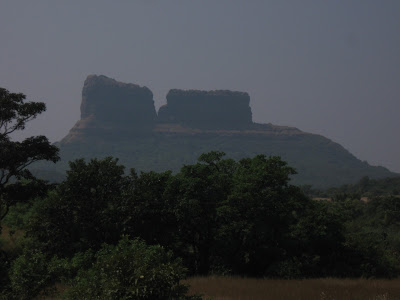These are the twin pinnacles of Tail Baila, a popular trekking spot near the Western Ghat escarpment about 100 km west of Pune. I get asked often whether Tail Baila is a volcanic plug or a dyke. It is neither. The pinnacles are lava flows. There is a strong structural control over erosion in this part of the Deccan Volcanic Province. Take a look at the satellite imagery below.
I have marked in orange arrows, a strong roughly N-S oriented fracture system. In yellow arrows is a less prominent E-W oriented fracture system. The white dotted line is the Western Ghat Escarpment. These fracture systems have their origins in the forces that broke apart fragments of Gondwanaland, with the Indian continental block separating from Madagascar around 88 mya and Seychelles breaking off from the Indian block about 66 mya. The latter rifting event coinciding with India drifting over a hot portion of the mantle known as the Reunion hotspot also triggered Deccan volcanism. Many of these fractures acted as conduits for magma to rise to the surface and spread as massive lava flows. Magma still occupies some of these fractures. These clogged up pipes are called dykes.
A paleo-geographic reconstruction of India in relation to other Gondwana continents and Asia during Deccan volcanism 66 million years ago is presented below.
Source: Sankar Chatterjee et.al. 2013
The legacy of these ancient cracks in the rocks didn't end with Deccan volcanism but has influenced the evolution of the landforms we see today. Since the lava pile is fractured, physical weathering -aided by water seepage, disruption by plant roots and by temperature changes- peels off slabs of lava along these weak fractures faces. Rock falls are a common site at the base of many cliffs. Removal of blocks of lava eventually results in the formation of isolated mesas, buttes and pinnacles, remnants of once continuous lava flows. Streams follow narrow fracture zones and carve out steep sided canyons. The result, after eons of weathering and erosion, is a spectacular landscape with plateaus, narrow valleys, high basalt cliffs and pinnacles shaped as rectangular blocks like Tail Baila.
Update- November 17 2015: Since this topic is of great local interest let me add another thought. The Western Ghat escarpment also has been undergoing this type of physical weathering and erosion along cracks and fractures. The original location of this escarpment would have been tens of km west of the present line. For millions of years the escarpment has been retreating eastwards as lava blocks have peeled off the cliff face. The Deccan Plateau was much wider in the past. It is being eaten up by eastward erosion. Places similar to Tiger's Leap and Konkan Kada would have been to the west, earlier in geological time!
Last Sunday I drove with some friends on one of the loveliest back country roads in this part of the country. The interactive map below shows the route looping around the backwaters of the Mulshi Dam from village Valane to village Nive.
A gnarly trunk of the Peepal tree with the Mulshi backwaters
Thick lava flows of the Deccan Traps with crude columnar jointing.
In a distance a pretty colorful entrance to a temple is glimpsed through the trees.
Serene backwaters
A lonely stretch of road through a woodland...
opens up with vistas of grasslands, upland forests and high basalt cliffs
Throughout the Holocene this tug of war has continued... where farmland meets forest.
When I was in college, geology was a road less traveled by. I am so glad I took it.
..until the next time.













Great Article Sir! Keep it up!
ReplyDeleteWonderful article. Thanks for sharing. Apurva
ReplyDeletethank you Murugesh and Apurva.. !
ReplyDeleteWonderful.. Would love to read more from you on geology of Maharashtra
ReplyDeleteWonderful.. Would love to read more from you on geology of Maharashtra
ReplyDeleteReally enjoyed the photos--neat to see something of the Deccan volcanic province.
ReplyDeletethanks Hollis- it is a beautiful area to visit..
ReplyDeletethanks Sailaroo for reading...